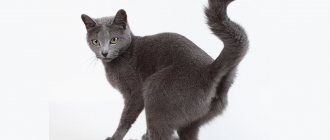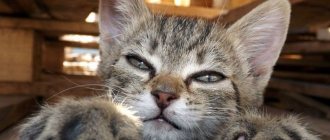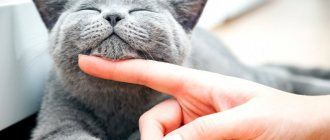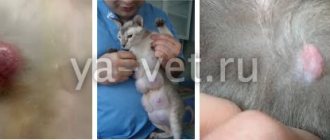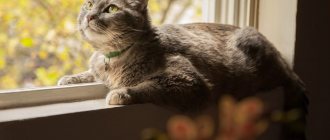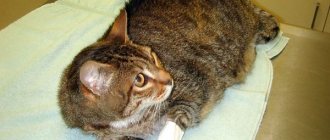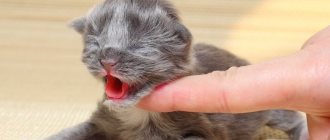A cat's nose as an indicator of well-being
The main function of a cat's nose is olfactory. Thanks to numerous (almost 20 times more than in humans) receptors, it helps completely blind kittens to freely navigate in space from birth. Babies deprived of sight and hearing always find their mother by reacting to surrounding smells.
The nasal sinuses are separated by a cartilaginous septum, and immediately behind them are the ethmoidal conchae. All odors entering this section are transmitted by receptors directly to the brain, which identifies the sniffed object or subject. The nasal bones of flat-faced breeds are deformed, making it more difficult for them to recognize odors and have a harder time breathing.
In addition to the olfactory, it is important to note the protective and tactile functions. The inhaled air is filtered inside the sinuses to remove dust and microorganisms and warms up to a comfortable temperature. The tactile function is performed by the lobe. This is what cats use to determine the temperature of food.
For the owner of a mustachioed pet, the latest function remains important, allowing you to assess your well-being without undergoing tests. If the animal is healthy, then its lobe:
- a little shiny;
- cool;
- wet;
- has no crusts or scales.
Humidity is achieved thanks to a special secretion secreted by the mucous membranes. It creates a protective film that protects the cat from the adverse effects of external factors, and helps to retain molecules of foreign substances to recognize their odors. Also, the wetness of the nose is associated with frequent licking, characteristic of the cat family.
Advice for caring owners
When communicating with our beloved pet, we don’t need words: we feel their love and affection, observe how playfully and carefree they show their habits, and admire their grace. As creatures of the wild, domestic cats live and experience this world through their baser instincts.
A happy pet creates the world around him through the care of his owner
You can get much closer and learn to understand your pet's signals and behavior by learning basic information about the structure of their amazing organisms. Regular care and attention to your pet will make you a rare guest in the veterinarian's office.
Why is my nose dry and warm?
A warm nose in cats is explained by an increase in body temperature (hyperthermia) and blood pressure. Such changes are not always explained by diseases - they can be the result of physiological processes.
Norm
Lack of moisture in kittens is associated with inability to maintain hygiene. Babies who do not know how to lick themselves completely rely on their mother cat. If separated from the mother too early, the owner will have to take care of the nose. Without timely moisturizing, it can crack, causing severe discomfort to the small pet.
If the usual activity and appetite are maintained, the cause of a hot nose in a cat may be:
- High activity
. Increased metabolism, necessary for muscle function, contributes to a rise in temperature and loss of fluid.
- Long sleep
. During rest, all internal processes slow down. The work of the mucous glands is no exception. The usual humidity returns some time after waking up.
- Dryness and high indoor temperature
. Under such conditions, the rate of moisture evaporation exceeds the rate of secretion production. That is why it is recommended to keep animals away from heating appliances. A humidifier can also help solve this problem.
- Low fluid intake
. Make sure your pet drinks its daily intake. Lack of water can lead to dehydration.
- Stress
. An animal's excitement is accompanied by behavioral changes: aggression, unsociability. When under stress, the cat will avoid communication and lick itself frequently. Knowing the cause of his worries, you need to try to eliminate it or use sedatives recommended by the veterinarian.
- Estrus
. This period is easy to recognize by loud songs, excessive affection and a characteristic posture.
Measuring body temperature using the lobe is not always accurate, since the owner is guided by his own feelings. If the pet’s condition does not return to normal, take a measurement with a rectal thermometer.
Dangerous reasons
If none of the physiological reasons are suitable, then a hot nose in a cat may indicate the presence of an illness. It can be identified by accompanying symptoms, but only a doctor can make an accurate diagnosis.
Diseases accompanied by hyperthermia include:
- neoplasms and foreign bodies stuck in the sinuses;
- injuries that prevent secretion production;
- diseases of the urinary system;
- rhinitis and sinusitis;
- inflammation and infections;
- trichobezoars that have clogged the stomach or intestines;
- helminthiases;
- poisoning and gastrointestinal disorders associated with overeating;
- tick infestations.
If you suspect any of the listed pathologies, it is recommended to immediately contact a veterinary clinic. The sooner the cause of the illness is detected, the less likely complications will arise.
Ways to provide assistance
If a cat’s nose becomes hot and dry without natural causes, this phenomenon does not go away for several hours, there are other negative symptoms - the best help for your pet is to call a veterinarian. It is quite difficult to determine the cause without qualifications. Independent choice of treatment often leads to serious negative consequences.
Cat owners need to remember that their pets should not be given antipyretics from their first aid kit. Paracetamol, Aspirin and other drugs are very dangerous for animals.
It is not always possible to make an urgent visit to a veterinary hospital; sometimes you have to wait a long time for the doctor to arrive. At this time, you need to provide first aid to your pet to alleviate its condition. The main danger at elevated temperatures is dehydration. The cat needs to be given cool water. If the animal cannot drink on its own, you can add a little water with a syringe. Long-haired pets can additionally be sprayed with a spray bottle. Pets without hair should be wiped with a damp cloth.
The first step is to measure your body temperature rectally. If it does not exceed 39.5°C, there is no need to knock it down before being examined by a veterinarian. But it is advisable to reduce the higher heat. To do this, you need to wrap an ice pack in a cloth and apply it in the armpits, groin, and head. You cannot cool one area for a long time.
Related signs and their meaning
You can guess why a cat has a dry and warm nose based on the accompanying signs. If at least one of them indicates a pathology, then the pet needs to be shown to a veterinarian.
Loss of appetite
Deterioration of appetite is typical for a weakened body. With infection, inflammation and disease of internal organs, refusal to eat is accompanied by apathy, increased sleep duration and a rise in temperature.
If the measurement with a thermometer does not show the presence of a deviation, analyze recent events. Some of them could cause severe stress. In this case, the problem can be dealt with with the increased attention and affection that the pet needs.
Hot ears
A kitten's warm nose combined with hot ears indicates hyperthermia. It occurs when:
- infection with ear mites, accompanied by an unpleasant odor from the ears;
- colds and ear infections (otitis);
- presence of injuries and hematomas;
- viral infections;
- stress;
- prolonged stay in a warm and stuffy room.
Physiological causes can be easily eliminated on your own. If the matter lies in pathology, then it is better to seek help.
Unusual nose color
Another cause for concern is any discoloration. Blueness is characteristic of intoxication, yellowness is characteristic of kidney failure, increased redness is characteristic of a burn, and unnatural pallor is characteristic of heart pathologies.
Painful symptoms
With damage to the gastrointestinal tract and most viral infections, the animal will experience vomiting and diarrhea. Much can be said by the appearance of vomit and feces. If blood appears, your pet must be hospitalized immediately, as such a symptom indicates the presence of internal injuries.
In addition to changing the color of the mucous membranes of the nose, it is important to consider the nature of the discharge. Discharge from the nasal sinuses can be clear, serous and purulent. A cold causes sneezing, red eyes, and breathing problems. Parasite infestation is often accompanied by hair loss and deterioration in hair quality.
Difficulty breathing, anemia, sudden weight loss, seizures and paralysis are characteristic of malignant neoplasms. If you notice an unsteady gait and excessive drooling, you should immediately contact a veterinary clinic. These symptoms indicate damage to the nervous system and can lead to very sad consequences.
First diagnosis
A careful examination of the cat is very important to make the correct diagnosis.
If one or more alarming symptoms are observed, the first thing the owner needs to do is carefully examine the pet.
- Check skin and coat.
- Find out the presence or absence of wounds , ulcers, rashes.
- Examine the mucous membranes of the nose , ears and eyes for discharge or discoloration.
- In normal condition, all mucous membranes should be pale pink . If there are deviations in any direction - the color is too pale or bright red, you should immediately consult a doctor.
- Examine and feel the cat's belly for bloating, pain, or increase in size.
- Feel the bladder to determine the level of fullness.
- Carefully inspect the cat's litter box .
- Find out the amount of stool , presence of impurities, change in color, consistency.
Temperature measurement
Every owner's house should have a special thermometer for animals.
Be sure to measure your temperature with a thermometer.
Monitor the cat's breathing. This can be done by placing your hand on your stomach or counting the number of inhalations and exhalations. The norm is from eighteen to thirty-three inhalations and exhalations. Females may have about ten more inhalations and exhalations than males.
The opposite problem is that the nose is too wet.
Although wetness is the recommended condition for a cat's nose, in some situations it can indicate pathology. Such exceptions include:
- Cold
. Due to a runny nose and frequent sneezing, the earlobe does not have time to dry out.
- Allergy
. The number of discharges correlates with colds. The only difference is that the symptoms disappear soon after the allergen is eliminated.
- Tumors, polyps and foreign objects
. Trying to get rid of the obstacle, the body produces an increased amount of mucus. If internal damage occurs, the discharge may contain blood or pus.
- Hypothermia or poisoning
. In addition to mucosal sputum, a decrease in temperature is noted.
- Infections
. Hot ears and copious discharge from the sinuses are characteristic of rhinotracheitis and panleukopenia.
- Cardiovascular diseases
. The appearance of increased humidity is accompanied by blanching of the mucous membrane.
This variety of possible interpretations confirms the danger of self-medication. An incorrect diagnosis can lead to aggravation of the real problem and deterioration of the animal's condition.
Symptoms that require doctor's attention
Use caution and seek medical attention if you notice any serious changes in your cat's behavior:
– the animal has become lethargic, apathetic, refuses to eat;
– sleeps a lot, does not respond to calls to play, is indifferent to favorite treats and entertainment;
– the cat’s stool becomes more frequent or worse, and vomiting appears;
– increased salivation is observed;
– green nasal discharge and sneezing appeared;
– the animal reacts negatively to an attempt to touch it;
– body temperature is increased, paws and ears turn red and become very hot;
The presence of such symptoms is a reason to immediately visit a veterinary clinic.
Treatment of ear diseases
To make a diagnosis, it is necessary not only to see the picture of the patient’s clinic, but also to take into account various tissue tests.
The doctor will prescribe treatment depending on the sum of all indicators.
- These can be antimicrobial, antiviral, antiallergic drugs, antibiotics and homeopathic remedies.
- The treatment process can be adjusted, especially with regard to fungal infections and mites.
- For hematomas and neoplasms, the help of a surgeon will be required.
Self-medication can only complicate the process. It is necessary to remember not only about the complications, but also about the harm that can be caused to your little friend when using inappropriate medications.
